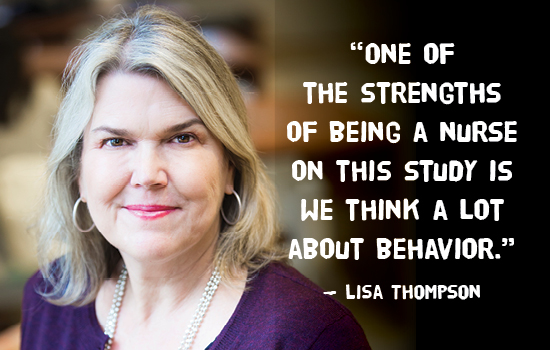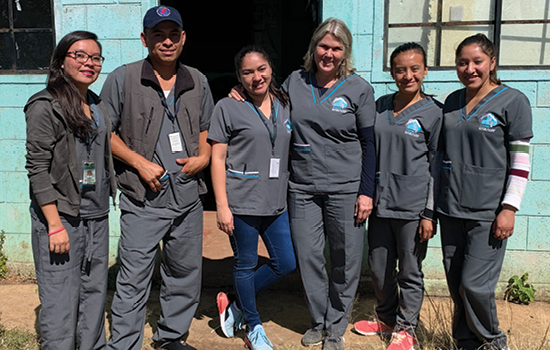Better air, healthier families
By Leslie Church

A new gas cookstove in a kitchen in Guatemala. Guatemala photographs courtesy of Lisa Thompson
While cooking your dinner over an open flame may sound nice for a camping trip, imagine having that fire permanently located inside your house; the throat-choking smoke, the stinging, watery eyes, the walls blackened with soot. And those are just the problems you can see.
Inside the body, smoke from a cooking fire wreaks havoc on the lungs and cardiovascular system. Those most affected are the ones doing the cooking—usually women—and the young children staying close to their mothers. Almost half of the world’s population cooks over solid fuels like wood, dung, and coal.
Pollutants from the smoke damage the body’s immune system response and more than double the chances of getting sick with a lung infection like pneumonia, the leading killer of young children in low-resource parts of the world.

What can be done?
That’s a question Associate Professor Lisa Thompson RN FNP-BC MS PhD FAAN has been investigating for the past 20 years. Starting in rural Guatemala, she initially focused on chimney stoves. Her research currently looks at trial use of gas stoves in mountain communities.
“At first we thought that chimney stoves would stop the household air pollution problem,” says Thompson. “But we found that all that smoke just goes up and outside and creates pollution outdoors, where people also work and play.”
The HAPIN (Household Air Pollution Intervention Network) trial is looking at the effect of having a gas cookstove and free fuel for 18 months on 3,200 pregnant women and their babies in Rwanda, Peru, India, and Guatemala. The study, led by Professor Thomas Clasen from the Rollins School of Public Health, is the first randomized control trial of its kind.
Thompson and a team of 20 Guatemalan nurses developed a standardized assessment of the infants in the trial. In addition to surveillance for pneumonia, they are evaluating the effects of cleaner household air on birth weight, preterm birth, child development and growth. They’re also looking at cardiovascular outcomes in pregnant women and older adult women living in the homes.
“Respiratory problems are common here,” says Flor Esteban Jiménez, clinical supervisor for the field team of nurses. “I am sure the study will have a big impact on our communities since there are 400 families participating.”
Looking at behaviors and incentives
Thompson, who co-leads the Guatemalan research site with investigators from Universidad del Valle de Guatemala, is the only nurse investigator on the trial.
“One of the strengths of being a nurse on this study is we think a lot about behavior,” Thompson says. “Before we implemented the gas stoves, we looked at how household decisions are made about cooking, and what barriers might exist.”
Thompson and her team ran exercises like a role-playing scenario where women pretended to ask their husbands for money to refill the gas tanks. They also did taste tests with local women on beans and porridge cooked over gas. They found the beans were softer and more evenly cooked, and the porridge was preferable because it didn’t have ash in it.
But the biggest incentives were time and convenience. Traditional stove users spend hours each week chopping and gathering wood. With gas stoves, women can turn on the flame and have breakfast ready for their families in minutes.
“During our focus groups, one woman jokingly said, ‘I feel so lazy now. I get up at six in the morning instead of four,’” Thompson says.

Lisa Thompson poses with some of the team in Guatemala.
Visible progress
The HAPIN trial began in 2017 and will assess more than 7,000 participants over the course of five years. The final question is, what will happen when the families are no longer receiving the free gas? Thompson and her team hope that evidence on the health benefits of clean cooking will motivate government officials to subsidize the stoves and gas for low-income families. “It just takes one interested politician to put that on the agenda,” she says.
India and Peru have already begun gas stove programs that benefit low-income families, and Rwanda’s government appears open to the idea, according to Thompson. The Guatemalan government hasn’t made it a priority, yet. But Thompson is hopeful.
“I think we put a spark there,” she says. “Less than 20 years ago, in another region, our research project built over 500 chimney stoves. That created a groundswell and now most people there have a chimney stove. A whole industry has built up around them.”
In the meantime, the women participating in the study are seeing the short-term benefits of clean cooking.
“They’re breathing easier, their clothes don’t smell like smoke—people can feel very stigmatized by that,” Thompson says. “And they’ve rebuilt their kitchens, painted the walls. Kitchens are no longer black from soot; progress is visible.”
Libny Monroy Alarcón believes some of the study’s health impacts will likely remain, even if the gas stoves are no longer used. Monroy Alarcón, a nurse sonographer who conducts ultrasounds on the infants and mothers, says “As part of the study, we educate participants on pneumonia and the importance of visiting health services to avoid complications. Now they'll be able to detect the signs and symptoms of pneumonia more easily.”
